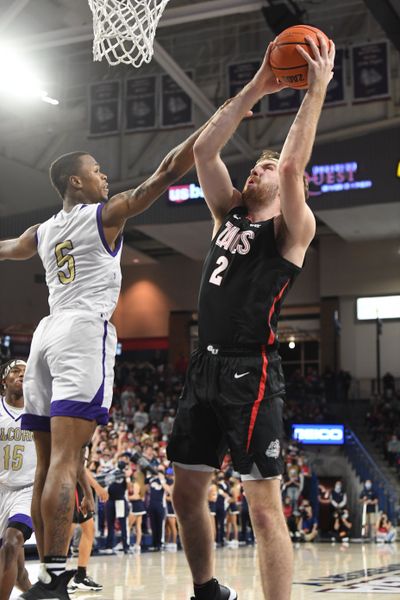Gonzaga-Alcorn State takeaways: Drew Timme’s passer rating rises

There was a stretch in the second half Monday when Drew Timme had a realistic chance at a double-double, and a triple-double wasn’t completely out of the question.
Several factors conspired against both possibilities, led by the fact that Timme simply wasn’t going to see much second-half court time in an eventual 84-57 rout over visiting Alcorn State.
If nothing else, the 6-foot-10 All-American showed his importance to the top-ranked Zags beyond his habit of filling the points column on the stat sheet. He did that to the tune of a career-high 37 points in Saturday’s win over No. 5 Texas.
Here are three takeaways from the Alcorn State game on Timme’s all-around evening, Gonzaga’s improving 3-point accuracy and the team’s defensive potential.
Dish network
Timme’s halftime stats: six points, five rebounds, four assists. His stats when he exited for good with 14:04 remaining: 10 points, five rebounds and six assists in roughly 19 minutes.
Timme’s passing can be overshadowed by his extensive collection of post moves, but it was the opposite against the Braves.
“We all know he can do lot of things on the court,” point guard Andrew Nembhard said. “When teams are doubling him like that, we just have to stay locked and loaded on the weak side.”
Timme’s assists per game have climbed in each of his three seasons, from 1.3 as a freshman to 2.3 last season. He’s at 3.0 through three games with all nine of his assists coming in the last two games.
His previous career high was five assists vs. Norfolk State in last season’s NCAA Tournament.
“He can pass now, he can really pass,” coach Mark Few said. “I think it’ll serve him well on the next level.”
Three cheers
After a rough start in an exhibition game and the first 20 minutes of the season opener against Dixie State, Gonzaga’s 3-point shooting is trending in a positive direction, especially over its last five halves (39.1%).
Gonzaga made 7 of 19 (36.8%) from deep against Alcorn State and Texas. That’s not shattering any records, but it’s more efficient than the frosty 29.2% vs. Eastern Oregon and 28.6% against Dixie State.
Last year, Gonzaga had one of college basketball’s best offenses in decades and made 36.8% on 3-pointers.
“I don’t think we’re too worried about the 3-ball,” said Nembhard, who was 2 of 3 from distance against Alcorn State. “We have a lot of guys that can stroke it from deep. Some guys are feeling it some nights, some won’t. We just have to keep shooting with confidence.”
Gonzaga’s five starters drained 7 of 12 3s, led by Julian Strawther’s 3 of 4.
“We all have confidence in each other,” Strawther said, “so if I see Andrew in the corner I’m going to find him and he’s going to find me.”
Defense delivering
Gonzaga’s defense was outstanding in the first half against Alcorn State and not quite as solid in the second half, following the pattern of the first two games.
The Zags limited both Alcorn State and Dixie State to 30% from the field in the opening 20 minutes. Texas made just 35.7%. All three opponents’ point totals and shooting accuracy climbed significantly in the second half, some of that is likely a product of Gonzaga substituting liberally against Dixie State and Alcorn State. Texas has numerous proven scoring options.
“Especially that first half (Monday), it was kind of exactly what we were looking to accomplish,” Few said. “I think we’ve had pretty much three halves just excellent on the defensive end, really adhering to the game plan and driving percentages down.”
Few likes the team’s defensive potential, but it’s far from a finished product.
“We have a team that can probably press up and pressure the ball. I don’t know that we’ve had that at all three spots, and (it’s) multiple guys, the guys coming in off the bench can do that,” Few said. “For the most part, we should have some good rim protection, but sometimes it breaks down a little bit. We have to grow the around-the-basket stuff.”